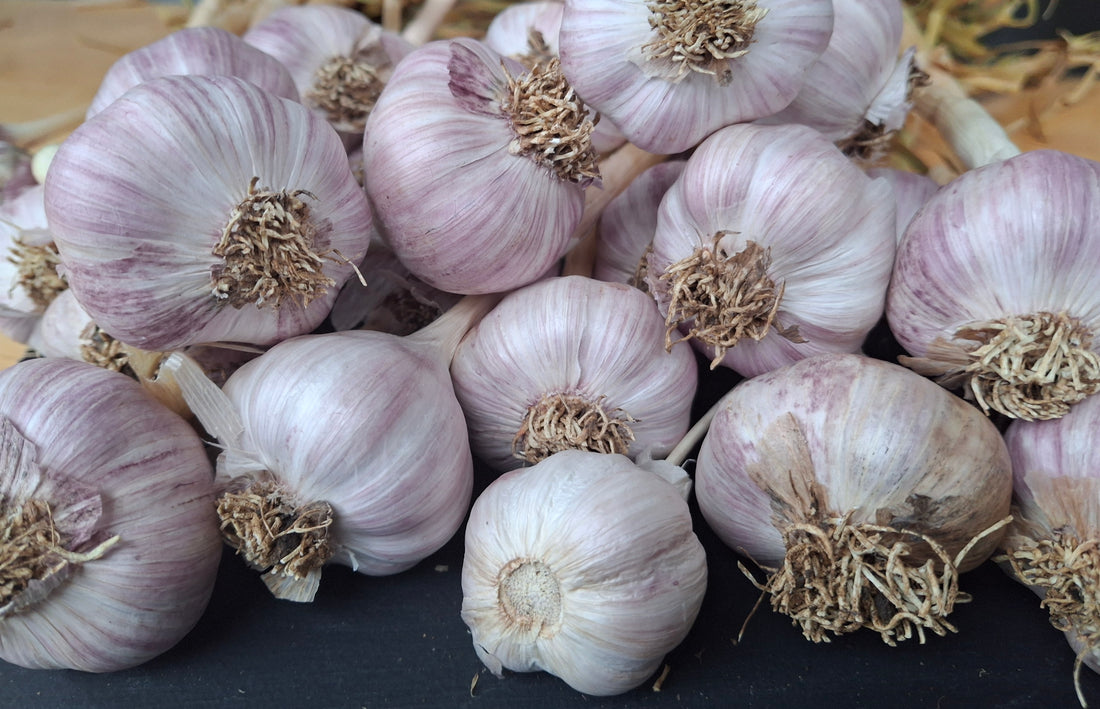
Growing Garlic
Share
Grow
Garlic is easy to grow at home
- Plant in March or late April, (Variety dependent)4-6 weeks before heavy frosts arrive in your area. Planting in Autumn gives garlic time to establish before winter.
- Ensure you choose good quality seed that grows well in your area. Garlic seed is the best and biggest bulbs saved from the previous year. When breaking down a bulb for seed you want to keep the largest cloves and use the rest for cooking. Smaller gloves will not produce sizable garlic. Over time the garlic you grow will adapt to your climate and be the best seed to use each year.
- Your garlic needs to have at least 6 hours of direct sunlight each day in winter
- Your soil needs to be well drained, loose and have a pH between 5.5 to 7.0.
- Garlic does not cope well in waterlogged or heavy clay soils and does not thrive among weeds or grass.
- Add organic compost several weeks before planting, we use chicken manure.
- Avoid planting your garlic seed in the same space each year so that disease is reduced
- Plant cloves pointing end up, flat end down 15-20cm apart and around 2cm deep. Cover in pea straw or mulch to retain moisture and suppress weeds
- Weed regularly and apply organic fertilizer like liquid seaweed to growing leaves in September, monthly dose is all that is required.
- If your in a dry region you may have to add a water source to your planting. Soil should be moist but crumbly, dried out or gluggy soil won’t grow great garlic.
Harvest
Garlic is harvest-ready in around eight months. Around November (and later depending on variety), outer leaves start to die away. When three or four green leaves remain, it’s time to harvest

Ref: Tasmanian gourmet garlic
Before harvesting to check if the bulbs have formed , gently shift a bit of surface soil and check for classic doughnut-shaped bulbs with clearly visible cloves. Watch the weather and aim to harvest after several dry days. If your bulbs resist being pulled up by the stem, lift them with a garden fork.
Gently dust off any soil still clinging to your plants.
Spread the entire plant (bulb, roots, and stalk) on a raised surface in your ‘drying zone.’
In most climates, curing garlic takes about 4 – 6 weeks. Once it’s dried, garlic will last for six months or more if stored correctly.

NOTE: An open shed, or one with high ceilings with windows, doors, or a side open often, makes a good spot for drying garlic.

Tips for best results:
- It’s much easier to braid bunches of garlic while the leaves are still green. Hang the bunches in a cool, airy spot to dry.
- If you wish to braid bunches of garlic that is brown, spray water on the leaves and leave for 10-15mins until soft, allowing braiding to be much easier.
- Your garlic is fully cured when the outer wrapper feels loose, and the leaves are brown and hardened.
- Use sharp scissors to trim the stalks to around one or two centimetres and roots close to the bulb. Use a soft brush or your fingers to dust off the remaining dirt from the bulb.
- Protect the cloves by brushing gently to avoid removing too many layers of the bulb wrapper.
Store
Properly handling dry garlic will ensure its freshness from winter to spring. Here's a guide on how to achieve that.
Pick a dark and dry place with moderate humidity, good airflow, and a consistent temperature around 15 -18C.
In the pantry or under an open cupboard are good options.
Use sturdy paper bags or your garlic can remain in our boxes that they arrived in, just place some holes in the bottom of the box for airflow.
Braided garlic or loose cloves can be kept in an open bowl on your kitchen bench.
Tips for best results:
- Avoid storing garlic in sealed paper or plastic bags - your garlic will suffocate and rot.
- Avoid direct sunlight, heat from stoves, kettles, and heaters.
- Big fluctuations in temperature cause garlic cloves to harden and dry out.
